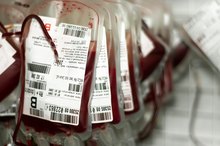What Is the Acceptable Range for Eosinophils?
Eosinophil granulocytes, often calledeosinophils, are leukocytes and one of the five types of white blood cells. Like other white blood cells, they are responsible for battling foreign materials that invade the body including infectious bacteria and parasites. A high level of eosinophils, usually over 500 eosinophil cells per micro liter of blood, can indicate an infection, parasitic pest or even an allergy. Consult a doctor at any sign of infection, allergy or parasitic infestation.
Eosinophils Occurence
Eosinophils can occur either in the blood or in tissue. Blood eosinophilia occurs when a high level of eosinophil cells are present in the blood stream. Tissue eosinophilia usually occurs at the site of an infection.
Testing
Light Red Blood Streaks in Phlegm
Learn More
Blood drawn for standard blood tests can be tested for blood eosinophilia. Samples from exploratory surgeries can be tested, as well as mucus and other fluids from the nasal passages. People testing positive for tissue eosinophilia generally do not have blood eosinophilia, according to the Mayo Clinic. Tissue eosinophilia is diagnosed with a biopsy of the relevant tissue.
Normal Blood Ranges
The normal range for eosinophil is less than 500 eosinophils per micro liter of blood, according to the Mayo Clinic. Anything above that level is considered abnormal and indicates a diagnosis of blood eosinophilia.
Causes of Eosinophilia
Side Effects From a Blood Transfusion
Learn More
Diseases such as asthma, Crohn’s and lupus can cause eosinophilia. Trichinosis, a parasite associated with undercooked pork, and Ascariasis, a common roundworm, are typical parasitic infections that can cause eosinophilia. Allergies can also cause eosinophilia.
Treatment
Eosinophilia is a symptom associated with other conditions. Treatment for the primary condition that caused the eosinophilia should result in the clearing of the eosinophilia.
Related Articles
References
Writer Bio
Keith Allen, a 1979 graduate of Valley City State College, has worked at a variety of jobs including computer operator, medical clinic manager, radio talk show host and potato sorter. For over five years he has worked as a newspaper reporter and historic researcher. His works have appeared in regional newspapers in North Dakota and in "North Dakota Horizons" and "Cowboys and Indians" magazines.









